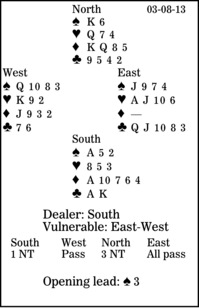Bridge column, March 8: Two ways to play, which way to go?

In today's deal, there are two roads that the declarer might take -- and many players would not even see one of them, ending up down one in their contract. South is in three no-trump. West leads the spade three. What are the two roads, which should declarer choose, and why?
South starts with seven top tricks: two spades, three diamonds and two clubs. Assuming he can collect five diamond tricks, he will be home. If that suit is breaking 2-2 or 3-1, it does not matter what he does. So he should consider a 4-0 split.
Getting that far, some declarers, after winning the first trick, say, on the board, would immediately cash the diamond king. Here, they would then fail and complain about their bad luck.
However, there is a second way to play diamonds successfully, when West has jack-fourth. South can cash his ace first, then twice lead through West to pick up his nine and jack. But why should declarer play West for the diamonds rather than East?
The signpost is West's opening lead. Assuming it was an honest fourth-highest, West began with exactly four spades. (He led the three and South holds the two.) If West is also void in diamonds, he would have at least five cards in clubs or hearts and presumably would have led that suit, not spades.
Use one piece of evidence to help with another.
** ** **
COPYRIGHT: 2013, UNITED FEATURE SYNDICATE
DISTRIBUTED BY UNIVERSAL UCLICK FOR UFS

